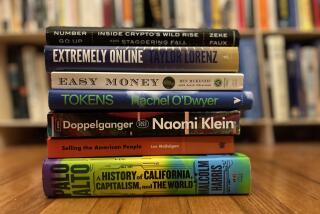On Leadership: Actually meeting the goals

- Share via
Now that the new year is well underway, it’s time to switch gears from thinking about what goals to set for the months ahead to thinking about how to actually pull them off.
Because we just finished the college football bowl season, the first book you may want to pick up is, “Above the Line: Lessons in Leadership and Life from a Championship Season,” by Ohio State football coach Urban Meyer and Wayne Coffey. Meyer breaks the mold of cliché-riddled leadership books by offering rock-solid principles on motivation, team building and empowerment as well as behind-the-scenes details about how he has built winning football programs at multiple schools and become a much better leader in the process.
For a look at leadership in the political arena, check out “Destiny and Power: The American Odyssey of George Herbert Walker Bush,” a biography written by Jon Meacham. Considered by many to be one of the best books of 2015, Meacham offers terrific leadership insights from George H.W. Bush, a man who served as president, vice president, congressman, ambassador and director of the CIA.
While the book made headlines for Bush’s candid and critical assessments of people like Dick Cheney and Donald Rumsfeld, it also offers insights into a leader who sought compromise and practiced civility with his political opponents to get things done.
In the more traditional realm of leadership books written by social scientists and academics, there are several that I would recommend.
One is “Superforecasting: The Art and Science of Prediction” by Philip E. Tetlock and Dan Gardner. In an era where big data is all the rage, this book offers a reminder that many predictions by experts are only slightly better than those of a monkey throwing darts at a board. The research by the authors shows that certain people – sometimes fairly ordinary individuals – prove to be extraordinarily effective at making predictions when they ditch the computer and instead rely on evidence from a variety of sources, examine probabilities, work in teams, and are willing to acknowledge errors and change direction.
Another book worth reading is Jeffrey Pfeffer’s “Leadership BS: Fixing Workplaces and Careers One Truth at a Time.” A Stanford University professor and the author of many best-selling business books, Pfeffer uses social science to poke holes in conventional wisdom and offers a more evidence-based approach to leadership development. He has an engaging writing style and provides plenty of practical examples and advice.
Amy Cuddy, a professor at Harvard Business School, uses her research to help leaders build the confidence they need to perform at their very best. Building off of her wildly popular TED talk about “power poses,” Cuddy’s book, “Presence: Bringing Your Boldest Self to Your Biggest Challenges,” offers concrete, simple techniques to fight the fear we all face in high-pressure moments. The approach allows leaders to achieve their goals and to empower others as well through daily tweaks to our mindset, body language and other behavior.
Maybe you are already doing a good job, but are eager to perform at a higher level using some innovative ideas. If this is the case, check out “Insight Out: Get Ideas Out of Your Head and Into the World” by Tina Seelig. Seelig explores concepts like imagination, creativity and entrepreneurship before outlining specific steps you can use to bring new ideas to life.
And even if you are confident and innovative, you may very well still fail. That’s where Brene Brown’s latest book, “Rising Strong,” comes into play. There’s a fan club dedicated to Brown’s work, and for good reason: She’s opened up new conversations about leadership, vulnerability and courage. This book tackles the reality that leading – and living, more generally – means you will inevitably fail. Speaking with leaders from large companies, the military, schools and individual artists, she’s uncovered some useful ideas for becoming more resilient in your professional and personal lives.
Tom Fox is the vice president for leadership and innovation at the nonprofit Partnership for Public Service. He is a guest contributor to the Washington Post’s On Leadership section.
More to Read
Inside the business of entertainment
The Wide Shot brings you news, analysis and insights on everything from streaming wars to production — and what it all means for the future.
You may occasionally receive promotional content from the Los Angeles Times.










